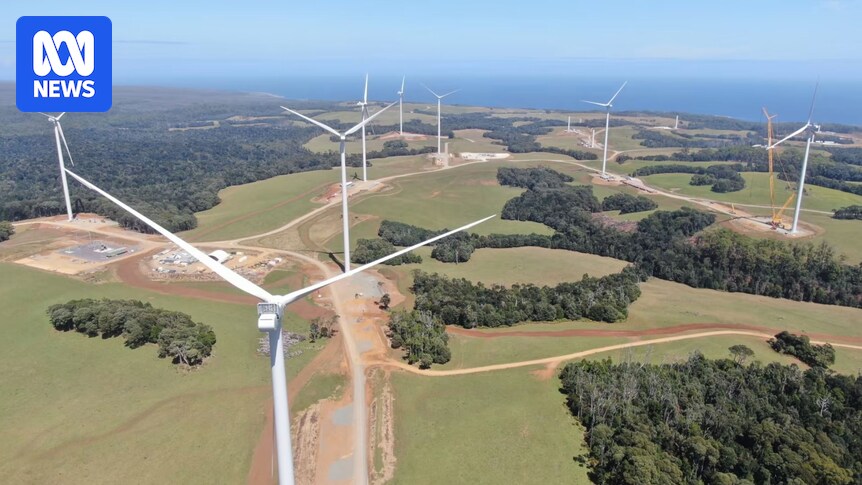Tasmania is headed for a 15-year low in its renewable energy generation — posing a threat to the state’s claim of being “100 per cent renewable”.
The driest year since 1934 in Hydro Tasmania’s catchments has forced the generator to scale back generation, with the aim of conserving water.
To meet the state’s energy needs, it has increased gas usage and is importing more energy than ever before from the mainland.
Renewables account for 79 per cent of the state’s energy mix, according to Hydro Tasmania. (Supplied: Tony Briscoe)
So far in 2024, Tasmanian renewable energy generation from solar, hydro and wind is equivalent to just 79 per cent of the state’s electricity demand, according to energy tracker OpenNEM.
That’s down from levels of 93 per cent, 93 per cent and 102 per cent across the previous three years.
One hundred per cent renewable doesn’t mean that all the energy used in the state is renewable, rather that the full capacity of the state’s renewable energy systems is greater than the amount of energy typically used in a year.
At times, Tasmania generates more than it uses and sells that into the national grid — at others, it buys from the grid to meet its power needs.
But a lack of rain has meant Tasmania’s “battery” — its dams — weren’t charged up enough.
Dry times take their toll
Hydro Tasmania’s 2023/2024 annual report notes most months saw below average rainfall.
“For a business that relies on rain, the very dry 12 months created challenges for storage management, generation and energy trading,” wrote former chief executive officer Ian Brooksbank.
The 31-turbine wind farm at Granville Harbour, Tasmania, came online in 2020. (Supplied: Atmos Renewables)
Loading…
The use of solar power has steadily grown in Tasmania over the last decade and wind generation has increased — peaking last year.
The gas-powered Tamar Valley Power station, which was fired up in June has accounted for 5 per cent of the state’s energy needs this year — the highest level since 2017.
Meanwhile, Basslink has been crucial in keeping the lights on, with a sixth of energy consumption coming from net imports of electricity via the undersea cable to the mainland.
According to OpenNEM, in 2024 about a third of the energy in the Victorian grid has been generated from renewables.
Hydro manages ‘abnormal’ conditions
Hydro’s general operations head Jack Penny said the dry conditions in the last year had been “abnormal”, however the generator had been able to maintain healthy water storages, and report a dividend of $122 million.
“Obviously, being a weather dependent generator, dry years can be very challenging — but we’ve got a number of different levers we can pull to manage that and make sure we’re acting for Tasmanians,” Mr Penny said.
He said Hydro was managing the impact of climate change, which he expected to result in higher rainfall variability.
“We’re going to have dry years, we’re going to have wet years,” he said.
“We have a lot of different options for managing those in the portfolio moving forward, and we work very closely with experts to understand what that might look like.”
Hydro is currently putting together business cases for expanding the Tarraleah Power Station, and a pumped Hydro scheme at Lake Cethana.
Tasmania’s peak business body says the state’s “complex” planning system is holding up investment in clean energy projects. (ABC News: Luke Bowden)
Business calls for more generation
Michael Bailey, Tasmanian Chamber of Commerce and Industry chief executive, said the low renewable generation figures were further proof Tasmania was in an “energy crisis”.
“Fundamentally, the number one thing we need in Tasmania right now is more clean energy production on island,” he said.
The last new wind farm in Tasmania opened in 2020, at Granville Harbour.
Mr Bailey said there were more projects held up by the “complex” planning system, jeopardising the goal of reaching 200 per cent renewable by 2020.
“What we hear from those developers is Tasmania is the most difficult place in the world to get these projects moving in, and we just simply need to do better than that.”
The Basslink undersea cable allows electricity to be traded between Victoria and Tasmania. (Supplied: Diving Co)
An final investment decision on the first stage of the $4 billion Marinus Link cable is expected next year — if approved, it would boost the capacity for trading with the mainland.
While it was initially billed as unlocking new renewable generation here, it is becoming increasingly important for Tasmania’s energy security, as demonstrated by record imports to meet demand this year.
Mr Penny said Hydro was constrained by Basslink during the last six months of 2023, when it was being paid to take energy.
“We would have taken more if we could have, which would have increased energy storages and put us in a much better position as the dry conditions continued.”
Head of general operations at Hydro Tasmania, Jack Penny. (ABC News)
Energy Minister Nick Duigan denied renewables accounted for 79 per cent of the state’s energy mix, however Hydro Tasmania confirmed the figure as correct.
Mr Duigan also said the government is establishing a dedicated renewable energy approvals pathway, and working with the federal government to improve and refine approvals processes.
“Tasmania’s latest greenhouse gas emissions report was released in August this year and Tasmanian remained at a net negative level of emissions for the ninth year in a row,” he said.
Loading…
